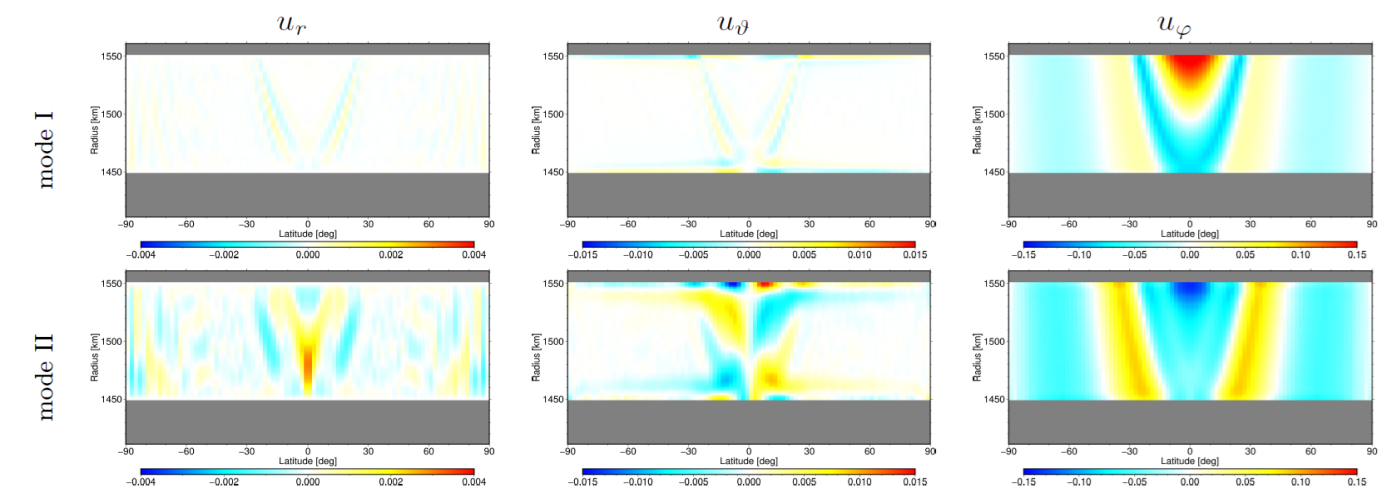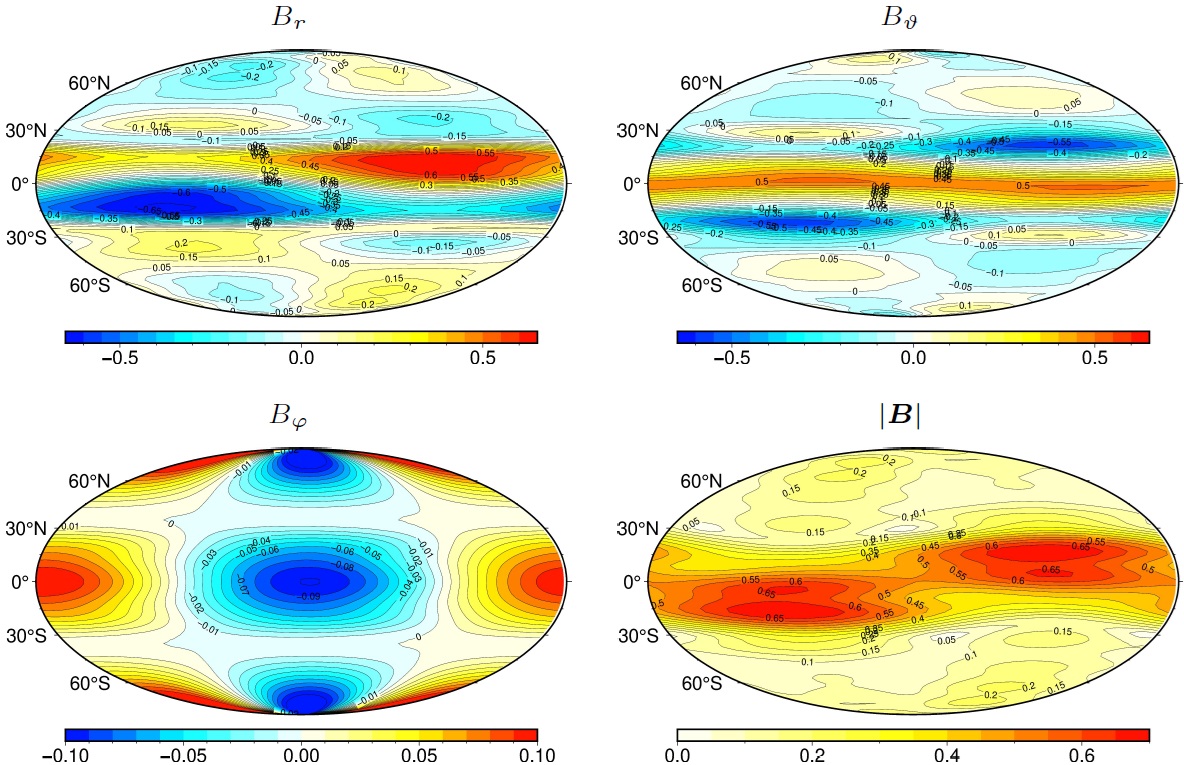Magnetic field induced by convective flow in Europa’s subsurface ocean
- Charles University in Prague, Department of Geophysics, Czech Republic (kvorka@karel.troja.mff.cuni.cz)
The electromagnetic (EM) methods played a crucial role in detecting the subsurface oceans in the interior of Europa, Callisto and Ganymede [1,2,3]. On Europa, the time-varying primary magnetic field generated by Jupiter [4] induces a secondary magnetic field, which was measured by Galileo probe at the synodic period. The comparison with the numerically modelled secondary field indicates that Europa’s shell is conductive, which supports the presence of highly conductive salty sea water in the subsurface ocean [5]. In that case, the ocean flow generates additional
magnetic field, the so-called ocean-induced magnetic field (OIMF), which has been overlooked so far. A notable exception is the study of Vance et al. [6]. They predicted the OIMF ≤ 20 nT using a simplified scaling relation in which they insert typical values of the primary field, electrical conductivity and flow velocity according to the flow model of [7]. Here, we revisit their results using a full EM induction solver. Besides, we rely on our flow model in order to conduct a systematic study specifically for the geometry estimates proposed for Europa [8,9].
The flow model is based on the Boussinesq approximation controlled by three non-dimensional numbers: the Rayleigh (Ra), Ekman (Ek) and Prandtl (Pr) numbers. As the computationally feasible values of Ek and Ra are orders of magnitude different from the realistic values [10], we built a dataset in order to establish an appropriate scaling law for extrapolation of the results. Previous studies have shown that Europa’s subsurface ocean is influenced but not dominated by the Coriolis force [7,10]. We show that two modes of convection can exist in this setting. Mode I is dominated by prograde zonal flow at the equator with negligible radial and meridional flows. Mode II is characterized by Hadley-like medirional circulation cells in both hemispheres
and prograde zonal flows occurring closer to the polar regions (Fig. 1). The scaling analysis based on our dataset strongly indicates that mode II is appropriate for Europa’s ocean. The proposed scaling of velocities yields values around 20 cm/s which is well aligned with energy estimates [11],
but at least 5x times lower than predicted by [7].

Figure 1: Two possible flow configurations in the ocean under a mild influence of the Coriolis force. Values are in m/s.
We calculate Europa’s OIMF using the time-domain EM induction solver ElmgTD [13, 14]. Compared to the frequency-domain approach, the time-domain solution naturally contains all not only the selected periods (e.g. synodic). The ElmgTD solver uses the vector spherical harmonic functions [12] in the lateral directions and piecewise-linear 1-D finite elements in the radial direction. ElmgTD is capable of working with 3-D conductivity distribution [15], but the lateral
conductivity variations in Europa’s interior are unknown yet. In all presented calculations, we consider a layered conductivity model. In each layer, the conductivity is constant and it represents (top to bottom): ice, ocean, silicate mantle and iron-nickel core. In such a case, the EM induction problem is decoupled for individual spherical harmonics which allows us to use high resolution (1 km) in the radial direction at low computational expense. Our calculations suggest that the magnitude of Europa’s OIMF forced by the flow mode II (see the second paragraph) is approximately 1 nT, see Fig. 2. Thus, Europa’s OIMF is more than one order of magnitude weaker than predicted by [6]. The discrepancy is primarily caused by more sluggish ocean flow and the correct treatment of EM induction. We obtain three times smaller OIMF if we use flow and conductivity models that mimic the setup of [6]. On top of that, Europa’s OIMF is affected by the conductivity and thickness of ice and ocean, which we demonstrate in a parametric study.

Figure 2: Europa’s OIMF [nT] in t = 4 h after the one-year spin up. Ice and ocean thicknesses are 1 km and 124 km, respectively.
[1] Zimmer et al., 2000, Icarus, 147, 329-347.
[2] Khurana et al., 2002, Astrobiology, 2, 93-103.
[3] Kivelson et al., 2002, Icarus, 157, 507-522.
[4] Connerney et al., 2022, J. Geophys. Res.: Planets, 127, e2021JE007055.
[5] Schilling et al., 2007, Icarus, 192, 41-55.
[6] Vance et al., 2021, J. Geophys. Res.: Planets, 123, 180-205.
[7] Soderlund, 2019, Geophys. Res. Lett., 46, 8700-8710.
[8] Petricca et al., 2023, Geophys. Res. Lett., 50, e2023GL104016.
[9] Casajus et al., 2021, Icarus, 358, 114187.
[10] Gastine et al., 2016, J. Fluid Mech., 808, 690-732.
[11] Jansen et al., 2023, Planet. Sci. J., 4, 117.
[12] Varshalovich et al., 1989, World Sci.
[13] Velímský et al., 2013, Earth Planets Space, 65, 1239-1246.
[14] Velímský et al., 2005, Geophys. J. Int., 160, 81-101.
[15] Šachl et al., 2019, Earth Planets Space, 71, 1-13.
How to cite: Kvorka, J., Šachl, L., Čadek, O., and Velímský, J.: Magnetic field induced by convective flow in Europa’s subsurface ocean, Europlanet Science Congress 2024, Berlin, Germany, 8–13 Sep 2024, EPSC2024-976, https://doi.org/10.5194/epsc2024-976, 2024.